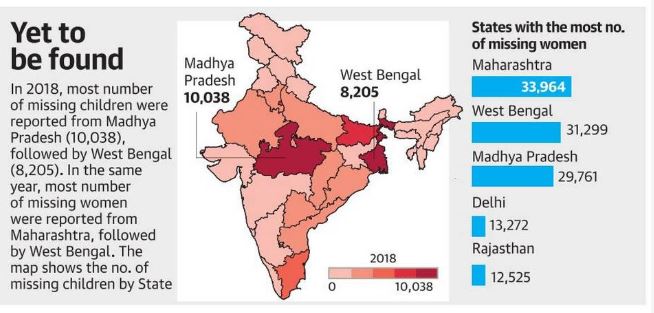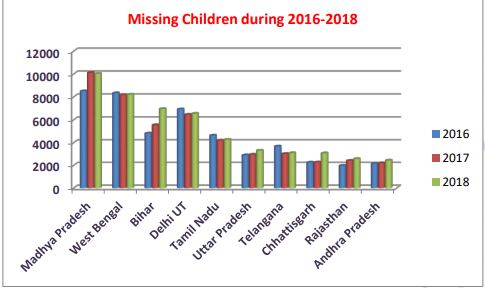Missing Women and Children in India | 04 Feb 2020
Why in News
Recently, the National Crime Records Bureau (NCRB) has released a study on missing persons (especially on women and children) in India.
- The analysis was directed by the Supreme Court of India in 2019 to identify the areas prone to child and women trafficking.
- Some parts of the country report higher incidents of missing children and women which could be one of the sources, transit or destination for child /women trafficking.
- The data for the study has been taken from the annual Crime in India (CII) report compiled by the NCRB for the years 2016, 2017 and 2018.
Global Scenario
- The United Nations Office on Drugs and Crime (UNODC) Global report 2018 on trafficking in persons indicates that the vast majority of the detected victims of trafficking for sexual exploitation are females.
- More than half of the victims of trafficking for forced labour are men and 35 % of them are females.
- The reasons for missing include mental illness, miscommunication, misadventure, domestic violence, and being a victim of crime. Whereas the common cause of trafficking is forced marriage, child labour, domestic help and sexual exploitation etc.
National Scenario
- Missing Women
- Maharashtra registered the maximum number of missing women followed by West Bengal.
- Maharashtra, West Bengal and Madhya Pradesh are three most vulnerable states.
- Mumbai and Pune (Maharashtra), Kolkata (West Bengal) and Indore (Madhya Pradesh) recorded the highest number of such incidents.
- Missing Children
- The number of missing children are maximum in the State of Madhya Pradesh, West Bengal, Delhi and Bihar.
- Indore reported the highest number of missing children. Whereas West Bengal’s Nadia district, bordering Bangladesh, showed a steep increase from 291 missing children reports in the year 2017 to 474 in 2018.
National Crime Record Bureau
- The National Crime Record Bureau (NCRB) was set-up in 1986 under the Ministry of Home Affairs.
- It functions as a repository of information on crime and criminals so as to assist the investigators in linking crime to the perpetrators.
- It was set up based on the recommendations of the National Police Commission (1977-1981) and the MHA’s Task Force (1985).
- NCRB brings out the annual comprehensive statistics of crime across the country (‘Crime in India’ report) since 1953. The report serves as a crucial tool in understanding the law and order situation across the country.


